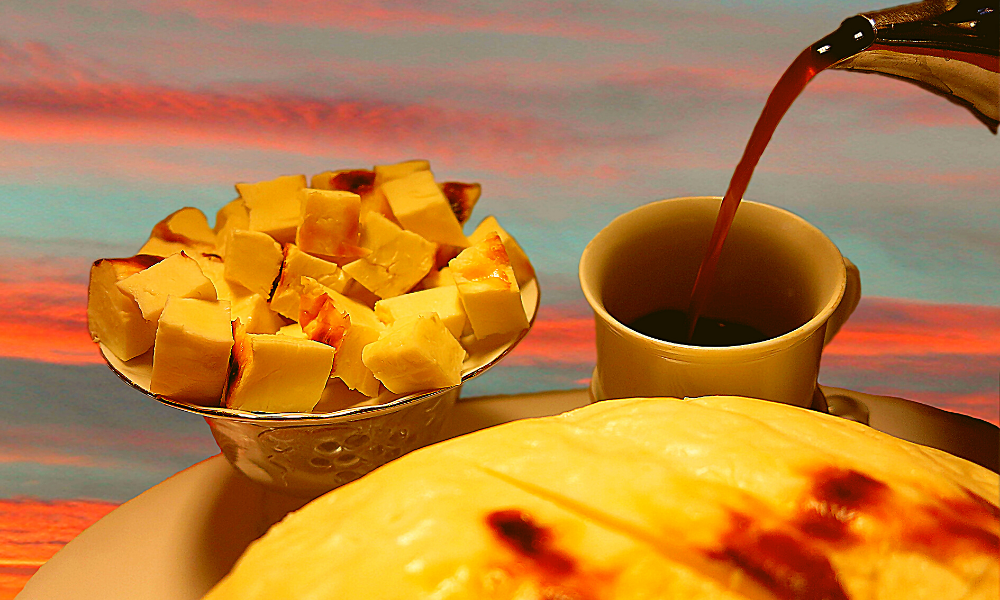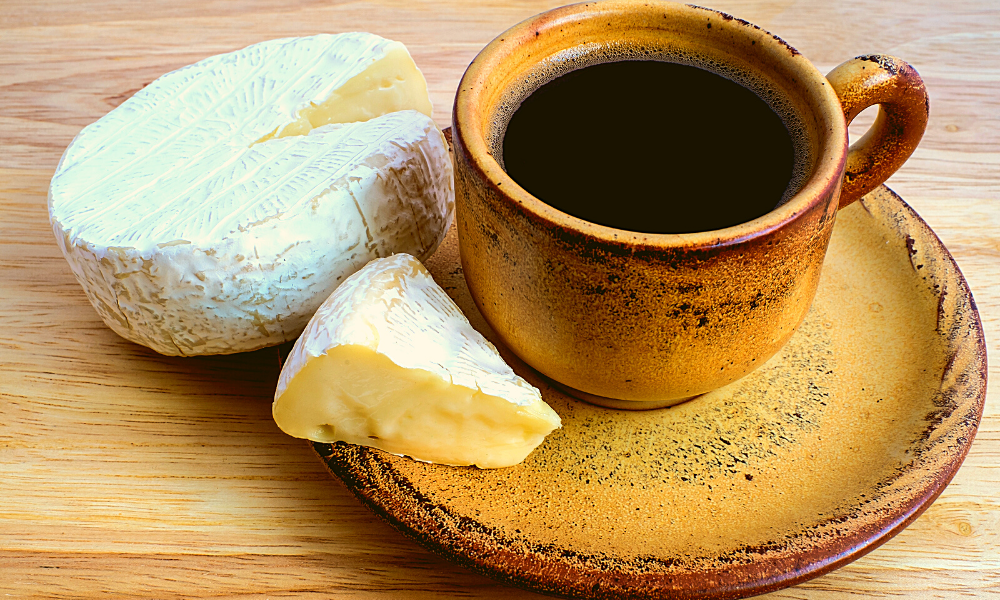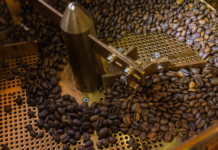Contents
Coffee has been the subject of many taste experimentations with people adding various things to coffee just to make it taste better, some different.
The most common things added to coffee are sugar and milk. The slightly more uncommon coffee addition is butter. Although bulletproof coffee is not gaining popularity.
But the weirdest and even more obscure combination is cheese in coffee.
Read More:
- Best Lipton Iced Teas
- Best Decaf Coffee: All You Need to Know About Decaf Coffee
- 10 Best Low Acid Coffee Brands Review
- Ninja Hot and Cold Brewed System Review
- Best Brazilian Coffee
Cheese in Coffee: What Is It And How It Taste?


Cheese in coffee also called kaffeost originated from Sweden and is quite popular there. However, in the past few years, it is beginning to surge stateside and around the world.
Kaffeost was first documented on the internet on the Atlas Obscura, talking about its Scandinavian origins.
Traditionally, cheese in coffee is made with cheese from reindeer milk. Today, however, goat’s milk or cow’s milk is now used. The cheese that is used here is also known as cheese bread or bread cheese since the feel and texture of the cheese is somewhat bready that cheesy.
Black coffee is poured into the wooden mug that is made of birchwood. Inside the mug, there are cubes of cheese. So, as you pour the coffee over the cheese, it starts to absorb the coffee like a spongy bread would.
You can either pick off the cheese as you would with marshmallows from hot choco or drink the whole coffee and eat the cheese later. Each bite exploding with a cheesy coffee flavor note. Read Here: Top 10 Best Espresso Coffee Beans
Not only that, the cheese also become spongy and nice once it absorbs the coffee, giving you a unique texture in your mouth. You need to have it while it is hot, though, if you want to have a taste the unique flavor profile of both coffee and cheese.
If you haven’t given cheese in coffee a shot, then you should definitely try it.
But wait, how do you make a bread cheese for your coffee?
Bread Cheese For Coffee Recipe
Bread cheese is remarkably easy to make and you can easily try one at home.
Ingredients:
- 2 teaspoons rennet
- 60ml heavy cream
- 2L whole milk
Note: A cooking thermometer can be very useful as well as a cheesecloth. If you don’t have cheesecloth, then you can use a clean handkerchief or a piece of cotton fabric.
Instructions:
- First off, you need to pour the milk into a saucepan.
- Then, add the cream.
- Next, prepare the rennet Most store-bought rennet will be in the tablet form. So, you can just crush the rennet and dissolve it in a small amount of water.
- Wait for at least 15 minutes for the rennet to be dissolved.
- Heat up the mil to 37 degrees Celsius very slowly.
- Remove from heat.
- Then, pour the rennet mixture and stir.
- Let the mixture sit for an hour.
- After that, you will see that the milk has started to curdle.
- Heat it up once again back to 37 degrees Celsius, stirring continuously from the outside to the center as you wait for the milk to heat up.
- Once the curds are almost in the center, increase the heat very slightly and bringing the mixture to an almost boil. Don’t forget to occasionally stir the mixture to evenly distribute the heat.
- Once the mixture is almost boiling, remove it from the heat immediately.
- Scoop the curds into a strainer that you have placed over a container or a pot. Make sure that you have placed a handkerchief or cheesecloth into the strainer.
- Scoop the curds then fold the handkerchief or cheesecloth over the curds.
- Gently press with your hands in order to get the excess water out of the curds as well as sticking them together. Just be careful since the curds will be too hot. You can use a wooden spoon to gently press.
- Once you removed as much liquid as possible, put some water in a saucepan and place it on top of the curds. Take note that it should still be wrapped in the cloth.
- Allow to sit for a few hours, letting the weight of the pot squeeze any remaining liquid.
- After a few hours, remove the open and open the cloth. Now, you should have a nice block of cheese to add in your daily brew.
Take note: If you want the cheese to have a bubbly and spongy texture, then you will need to bake it. Place the cheese into an oven-proof dish and put it in your oven.
Set the temperature to 350 degrees Fahrenheit and cook until it is golden. You should now have a bread cheese. Cut it up into small cubes and put them in your favorite mug.
Then pour some black coffee over it and enjoy as the cheesy and coffee notes combine.
Read More:
- Best Lipton Iced Teas
- Best Decaf Coffee: All You Need to Know About Decaf Coffee
- 10 Best Low Acid Coffee Brands Review
- Ninja Hot and Cold Brewed System Review
- Best Brazilian Coffee
Maroilles: The French Version of Cheese in Coffee
In the northern areas of France, the industrial and coal communities were used to dipping their cheese in coffee. Once exclusive to the North of France, the soldiers started exchanging recipes when communicating during the World War II and has not become popular even in Paris.
Their favorite cheese? Maroilles!
Although smelly that it is usually double wrapped to prevent its smelliness from going out, maroilles is often paired or dunked into coffee.
You can take a bite on maroilles then a sip of the coffee. Or just dunk it into the coffee itself and take a bite. The cheese will absorb lots of coffee and you will end up with a smooth and flavorful bite.
Other Types of Cheese Coffee


Other than the Scandinavian cheese in coffee origin, there are other forms of cheese coffee you might want to try.
One form of cheese in coffee that is really popular in the US today is made by Percolate, a coffee house in Los Angles, California. Their version of cheese coffee is inspired from their cheese tea.
Called the Bittersweet Tiramisu, these cheese in coffee is basically a cold brew coffee topped with a mixture of whipped heavy cream and sweetened cream cheese.
Another form of cheese in coffee is from Vietnam. This original recipe is coffee served with a whipped mixture of cheese and eggs. The coffee shop owner got the idea during a time of shortage of milk. Read Here: Top 10 Best Espresso Machines Under $1000
And even though the exact preparation is a secret, the ingredients include butter, egg yolk, condensed milk, coffee powder and cheese. This kind of Vietnamese coffee is more commonly known as egg coffee.
Coffee and Cheese Pairings
Now that you know about other forms of cheese in coffee, we would be remiss if we did not tell you about another way to have both cheese and coffee.
The more modern cheese coffee is actually pairing different varieties of cheese with coffee. With this method, you don’t necessarily dunk the cheese in coffee. Rather, you have a bite of the cheese and taking a sip of coffee right on top of that.
Cheese and coffee pairings open up avenues for lots of different flavor combinations which other people would not have otherwise been inclined to try.
Sweeter cheeses usually go well with most coffee since the flavors can balance themselves out.
Now, the key to a great cheese and coffee pairing is knowing the flavor notes present in both cheese and coffee, combining the opposing and complementing the flavors in an artful way.
Best Cheese To Pair With Coffee
Here are some of the best cheeses to pair with your favorite cup of coffee.
Barely Buzzed
What better cheese to pair with your freshly brewed coffee than one that’s already coated in coffee grounds?
Beehive Cheese Co. formulated the Barely Buzzed cheese that has a rind coated with lavender and coffee grounds. The lavender buds give off that faint floral flavor which surprisingly tastes with the coffee flavor and cheddar-like cheese.
In addition, the coffee covering its rind is ground into a fine velvety texture that makes it pleasantly and completely edible.
Ricotta
One of the cheeses that is almost like cream, Ricotta has this sweet flavor. So, pairing it with coffee is like putting a scoop of cream in your coffee.
The creamy and smooth texture will dance in your mouth against the strong coffee flavors.
Aged Gouda
When you pair Gouda with coffee, go with the more aged ones. Aged gouda offers a caramelized sweet flavor that can stand up and smoothen even the strongest cup of coffee.
It is almost like pairing a salty and sweet caramel candy with coffee. Gouda ages anywhere from 2 months – 5 years.
Piave Vecchio
An Italian cheese that carries the taste of its distant relative Parmigiano-Reggiano. This cheese offers a nutty, slightly fruity, and sweet flavor.
Aged for at least a year, its texture becomes slightly smoother and softer than the Parmigiano-Reggiano cheese with stronger flavors that complement with that of coffee.
Gjetost
A Norwegian cheese, gjetost not only looks like a giant slab of caramel toffee but also has the very sweet cheese flavor that tastes a lot like caramel.
It is made by gradually heating milk until the sugars turn brown and caramelize. Serving this sweet cheese with coffee is like serving dessert with coffee. It is one of the most natural pairings ever!
Cheddar
Known for its sharp taste, cheddar perfectly complements the pleasing bitter flavor of coffee as well as espresso. It also has some nutty characteristics which can further enhance the pairing.
Like gouda, this cheese is also aged for varying time period, so the more you age it, the more the flavors develop.
Fenacho
The semi-hard goat’s milk cheese is dotted with the fenugreek seed bring flavor hints of maple and butterscotch. The sweet and salty combinations of fenugreek and goat cheese is already a perfect combination, but further enhances the flavor of coffee.
The fenugreek plant is also known for its slightly sweet seeds that can be used in spice blends, coffee, and tea.
How To Pair Cheese and Coffee


Flavor
First, know the flavor.
Yes, that cheese tastes like cheese. But what other flavors are you taking?
These secondary flavors are what make each food items unique. Thus, you need to train your taste buds in order to pair properly.
Is there a green, asparagus kind of flavor going on?
Does it taste like mustard?
What about certain umami or sort of flavor note?
These pieces of information should give you a clue to what pairing will be the most successful.
Read More:
- Best Lipton Iced Teas
- Best Decaf Coffee: All You Need to Know About Decaf Coffee
- 10 Best Low Acid Coffee Brands Review
- Ninja Hot and Cold Brewed System Review
- Best Brazilian Coffee
Body and Mouthfeel
The easiest way to describe the body is thinking about the difference between drinking skim milk and cream.
The cream coats your mouth and lingering for some time. This is what considered to be full-bodied. Meanwhile, skim milk is not as viscous and does not hang around your mouth after swallowing it.
Due to that lightness, it is considered light bodied. Both cheeses and coffees have body. So, consider that body and mouthfeel.
Taste
This is a personal level. What tastes good for you probably won’t taste great for me.
To properly create a cheese and coffee pairing will depend on the tasting notes you want and prefer.
Coffee and Cheese Pairings
- If you have a light-medium bodied cup of coffee with high acidity, then you can go with the creamy cheeses such as ricotta or mozzarella.
- If you have a medium-full bodied cup of coffee with medium acidity, then you can pair it with blue cheese, brie, aged cheddar or even goat cheese.
- If you have a full-bodied cup of coffee with low acidity, then you can go with gruyere or smoked mozzarella.
Final Thoughts
With coffee, there is no right or wrong way to enjoy it. And you can add with anything that tickles your fancy. Also, with the creative taste buds of people, coffee opens up avenues for new culinary adventures like cheese in coffee.
Have you tried coffee in cheese yet? Share your experience through the comment section below! And please don’t forget to share this article with your friends and family!
Have a cheesy, caffeinated day!

















